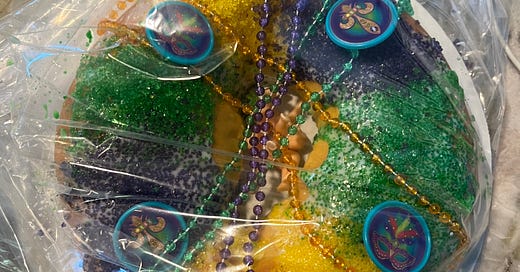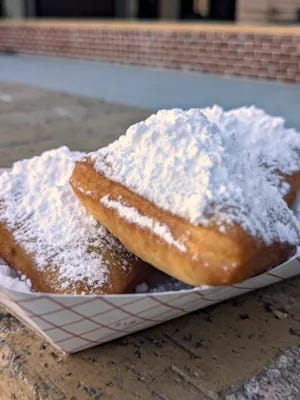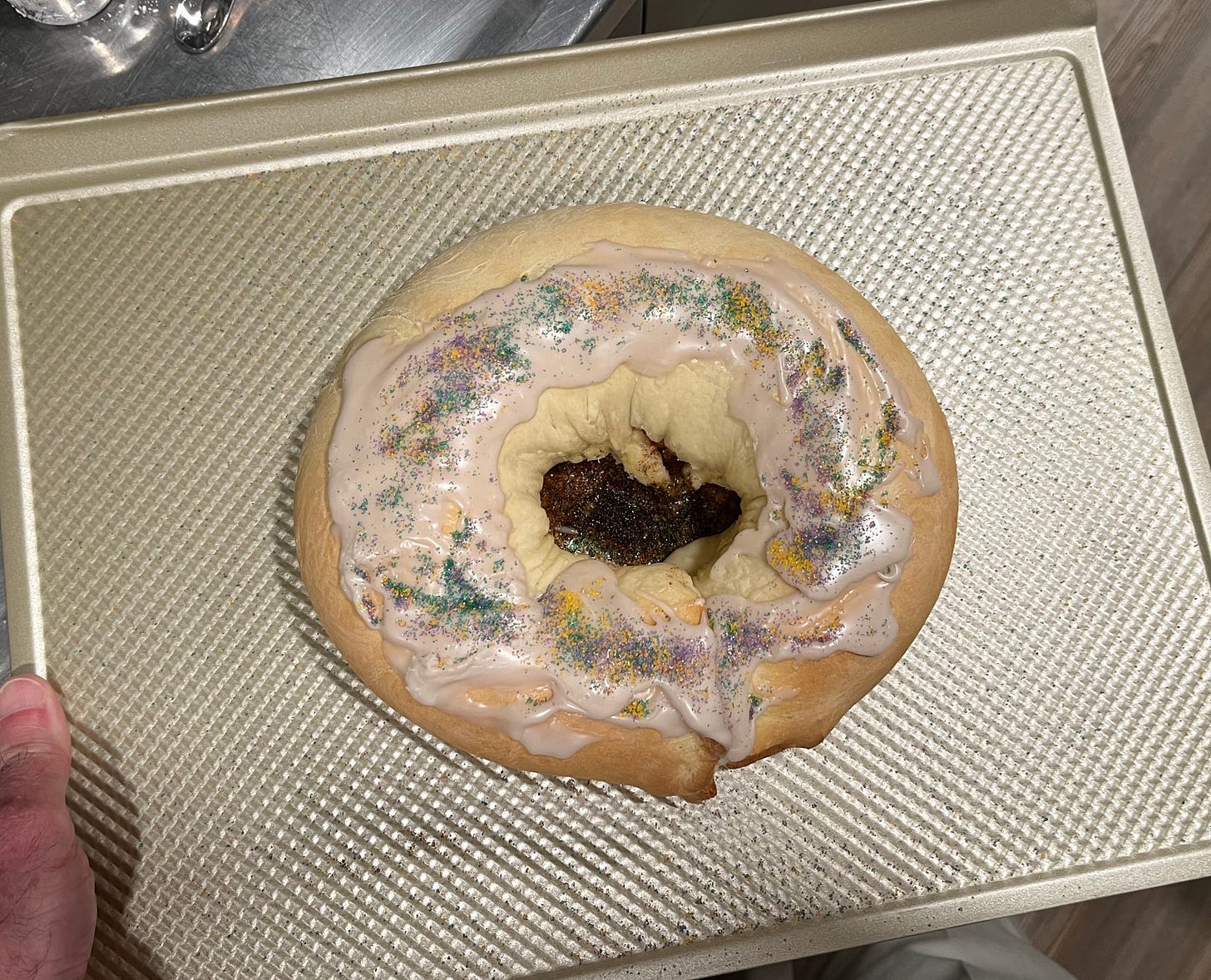What makes a book compelling? Join me in reading good books and honing the craft of writing.
Here’s a lagniappe post, outside of the regular schedule of first and third Fridays of the month:
You’ve heard of Pacific salmon originating in the Northwest and Atlantic salmon out of the Northeast.
I am a South Louisiana salmon, raised on Zatarain’s boiled shrimp, day-long simmering gumbos, po’boys so drenched, they drip as you bite into the French bread that’s crispy on top, soggy underneath. I can sniff out any shrimp and crab boil on an upwind breeze.
Which is why this time every year, the Epiphany season between Christmas and Lent, I’m pulled back to natal grounds, no matter how far I am from shrimp boats docked on the muddy water. That same water is the soup for making oysters, redfish, speckled trout.
As a smelt, I served time on the ground along parade routes, too short to see up close the Mardi Gras floats through the forest of adults and ladders. Later, I lengthened enough to see meandering on the current the vibrant yellows, greens, and purples, that garish color combination only us locals think naturally go together. My status didn’t last, as I swam away to earn a living and raise a family.
No matter, I’d frequently make the migration back to partake in Mardi Gras. Not the Mardi Gras of youth, where stale beer cast a fermenting plume over the streets, where parade-goers were both friendly in making conversation and territorial, staking out front row plots. This was the Mardi Gras for my kids, plenty of room to watch, even friendlier crowds, certainly more sober. One year, an ice storm dealt the sobering realization of failure. The kids in the back, the car slipping, we threw in the beads and turned back.
In the years when I stay put, when I don’t swim upstream in a southerly direction, I am restless. Not a circling nutria wanting out of the pond kind of restless. Not an alligator unflinching and motionless, lying in wait for dinner and then striking out. It’s a pull to return to the sounds of the crowd, murmuring in wait and then yelling for plastic trinkets from the riders on the floats, of swaying to the music of the marching bands.
And of course, the food.
I’ve learned to cope with missing Mardi Gras. I’m still pulled back to visit New Orleans. I tell my wife when my hands buzz, it’s nature calling me home. She’s kind enough to go along with my whims.
Here’s how I cope with missing the migration. I indulge in the foods of old. Shrimp and gumbos, of course. Once, we bought shrimp off the boat and took them back to our AirBnB. We forgot shrimp heads come spiked. By the time we double bagged our catch for the trip home, the kitchen was a shrimpy mess from leaks. Being good tenants, we cleaned up every surface and rid the place of seafood smells. All worth it to lay in a store of shrimp for the stay-at-home time.
Jambalaya too. Easy to make and try different varieties. Crawfish when they’re available. Boiled is the best. Dump them out on a tray, along with new potatoes, half ears of corn to sop up the unused cayenne in the boil seasonings
But it’s beignets and king cake that keeping me going though Mardi Gras season. Beignets, little more than rectangles of dough that puff exponentially when fried, usually form our first stop when we revisit. And underpin my memories. So it is that beignets are necessitated during Mardi Gras. The problem of migrating away from home is the paucity of local beignet shops. With beignets, the eating is the pleasure, the deep frying the work. All that grease to contend with deters any desire to make them at home. And beignet shops come and go, as for some strange reason, the market slants niche.
I’ve discovered some local beignet shops that tide me over. In North Texas, there’s Dusty Biscuit and Le Bon Temps, where the owner explained that humidity and air temps can mess with the preparation of beignets. To pass as a native beignet-eater, say you want an “order,” and they’ll understand you want three beignets. Powdered sugar drenchings are a must; dustings won’t do.
King cakes face the same supply-side challenges as beignets. If you find a local bakery who makes king cakes, visit often. My local go-to is Bluebonnet Bakery, appropriately housed in a former bricked church. I’ve made it a goal to keep them in business a little longer.
Where in your area are places for beignets and king cakes?
Better hurry though. King cakes disappear when Lent starts and the off-season is a long ten-and-half months. You’ll have to be like me and rely on beignets, whether sourced locally, or ordered over the counter in South Louisiana.
We’re not alone in our exploration of king cakes:
In this installment, Grazing tells of a Vietnamese bakery’s king cakes in New Orleans East. King cakes need not be a round ring.
Life's a Feast shares some history of and a recipe for the French gateau des rois.
King cakes are traditionally a brioche. Nicola Lamb entertains and gets us salivating with her informative Kitchen Project #125: Laminated Brioche. I’m now a subscriber, and hoping for an invite to her kitchen. I’ll measure, stir, knead, anything.
Jordan Revon provides this recipe for Maw Maw Olga's King Cake, using cream cheese.
Before I found Maw Maw’s, I made this one with sour cream:
It lasted all of a couple of days.
All the Best,
Geoff
If you enjoyed this post, please hit the heart “❤️” so others can find it. It’s at the bottom and at the top.






